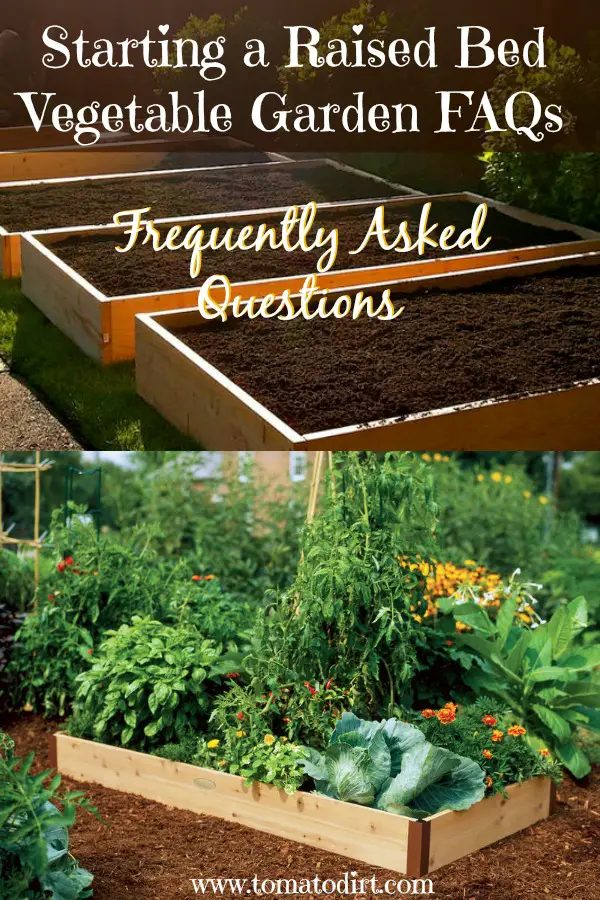FREE: 10 Must-Know Tomato Growing Tips Get The Guide
Read our affiliate disclosure here.
Starting a Raised Bed Vegetable Garden: FAQs
Since 2010, Tomato Dirt has garnered 4.8+ million views, making it the web’s leading online source for growing tomatoes in the home garden. Award-winning writer and Tomato Dirt owner Kathy Widenhouse has helped thousands of home gardeners grow healthier tomatoes. Be one of them when you get Tomato Dirt’s Growing Guide here.
Updated 1.18.25
Starting a raised bed vegetable garden takes a little bit of effort to set up, but the benefits are enormous season after season.
A raised garden bed (also called a “garden box,”) is a frame set directly on the open ground and then filled with organic matter and soil. The bed allows you to grow vegetables or flowers in a small space. The sides of the bed keep weeds out of the garden, prevent erosion, deter pests, prevent soil from compacting, offer good drainage, and more.
Can you tell that I’m a fan?
(Find step-by-step instructions for setting up a raised garden bed.)
Plenty of gardeners have found the raised bed option to be convenient and productive. Here are some of questions you and gardeners like you may have about starting a vegetable garden in raised beds.
Starting a Raised Bed Vegetable Garden
Q. Why should I consider starting a raised bed vegetable garden?
A. It’s a great option if you have only a small space or if you don’t have lots of free time. Managing a raised bed garden is easier and takes less time than maintaining an entire garden plot. And raised beds are a good choice if you have a space that is an eyesore or has poor soil. Still other gardeners give this reason: “They keep my growing space looking neat and tidy – and they produce more veggies.”
Q. When should I set up my raised bed?
A. Anytime, although early spring is the most convenient time since growing season is just around the corner.
Q. How big are raised beds?
A. Whatever size you choose. Build raised beds to fit your space. A good rule of thumb to follow is that they should be no wider than 4 feet on one side. This allows you to reach in from both sides to weed, cultivate, and harvest plants. The ideal height is up to you. Some gardeners, particularly the elderly or disabled, prefer raised beds that are waist high.
Q. I am not handy with construction. Can I still put together raised beds?
A. Of course! Many gardeners purchase raised beds that are ready-made or easy to put together from kits … with step-by-step instructions included. Plus, all raised beds are not built from wood, metal, or plastic – some gardeners even use cinder blocks. (Here’s a quick tutorial about how to choose raised bed building materials.) You can even DIY your own low cost raised garden beds with materials you already have at home or that you can get from local sources.
Q. Do I need to work the soil underneath the bed before I fill it?
A. Yes, it’s a good idea. You’ll remove rocks and debris and loosen the soil, which will help your vegetables grow deeper roots and access nutrients below the surface. Fortunately, this is a job that needs to be done only once – when you set up the bed! Work 12-24 inches below the soil surface and then add compost, humus, top soil, and other organic matter, just as you would when preparing a garden plot.
Q. How many plants fill a raised bed?
A. A 4 x 4-foot raised bed can accommodate 5 or 6 low growing plants like cucumbers, squash, herbs, and zucchini. You can plant a couple of taller crops (like tomatoes) in the center. Set up a trellis in a longer raised bed (8 feet or longer) to grow vining crops like beans.
Q. Should I plant seeds or seedlings in my raised beds?
A. Follow the same rule of thumb that you’d use when planting vegetables in a garden plot. Some crops do best when sown directly into your raised bed vegetable garden – lettuce, radishes, beans, basil, cucumbers, squash. You’ll be more successful with other crops when you plant seedlings – tomatoes, for instance, and perennial herbs and peppers.
Q. How should I water my raised bed?
A. Situate your raised bed near a water source or set up a drip irrigation system.
More about Gardening in Raised Beds
Raised Beds for Tomatoes: the basics you need to know ...
7 Benefits of Raised Beds for Gardening ...
8 Low Cost Raised Garden Beds You Can DIY ...
What to Put on Bottom of Raised Garden Bed ...
16 Cost-Saving Tips for Do-It-Yourself Raised Garden Beds ...
8 Guidelines for Growing Raised Bed Tomatoes ...
6 Tips for Growing Tomatoes In Raised Garden Beds ...
Materials for Your Raised Garden Bed: a primer ...
Starting a Vegetable Garden: What You Need to Do ...
Preparing Your Soil to Grow Tomatoes and Vegetables ...
More about Raised Beds for Tomatoes on our Pinterest board ...
Return from Starting a Raised Bed Vegetable Garden FAQs to Tomato Dirt home
As an Amazon Associate and Rakuten Advertising affiliate I earn from qualifying purchases.
SHARE THIS PAGE:
FREE! 10 Must-Know Tomato Growing Tips: 20-page guide
Get yours here:





New! Comments
Have your say about what you just read! Leave a comment in the box below.